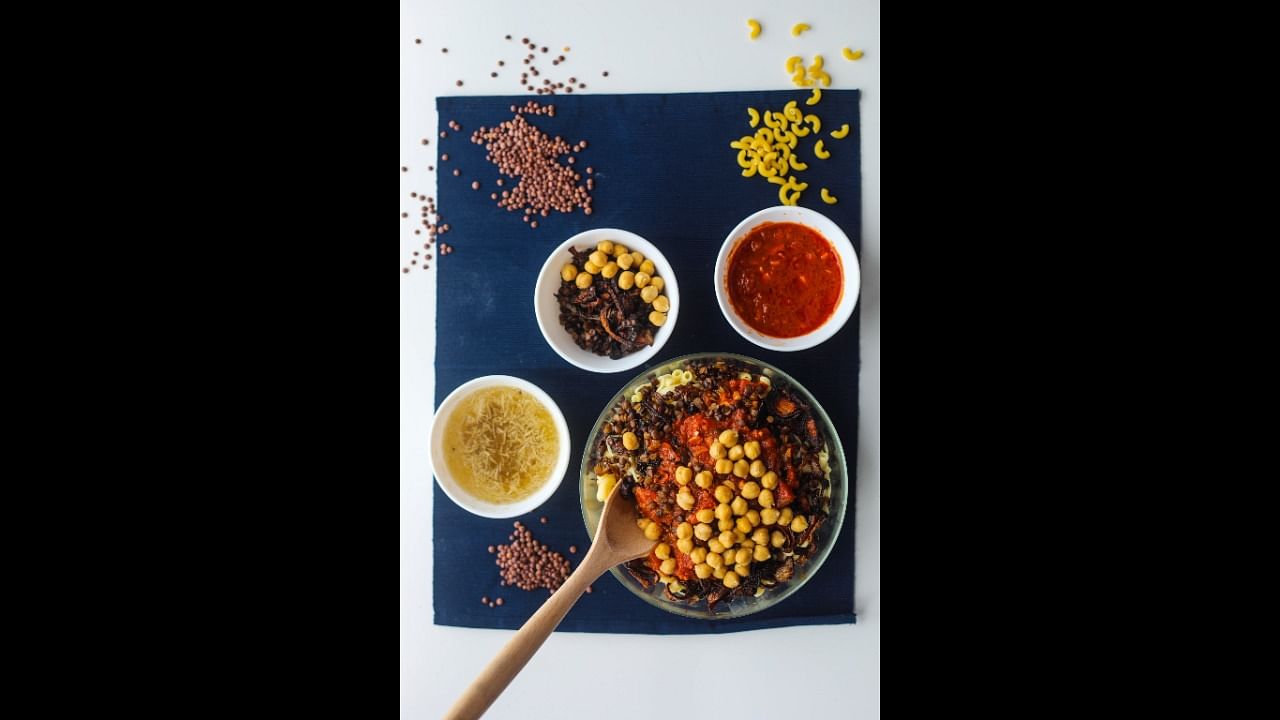
As I write this, I am already salivating imagining the very carb-loaded, but super delicious dish that my local guide excitedly introduced me to. He said, “If you are a vegetarian and foodie, you will not forget this memorable treat.” I can totally vouch for his words. I was thrilled to indulge in the most desirable, beloved, and signature street staples of one of the most ancient cities. It may not be as old as the pharaonic history or the pyramids but it is iconic, cultural, and special with a zingy kick. It is unusually chaotic in terms of its ingredients but indescribably satiating.
The uniqueness of this multi-cultural dish cannot be contested. Anyone who has savoured it knows that the mention of it is enough to send your stomachs growling and mouths watering.
To first-timers, it may not sound enticing, and even its humble accompaniments may seem uninteresting but the journey from the first bite to the last bite will only convince you that it is one compelling bowl of comfort food. In the culinary lexicon, it is called Koshari.
Let us decode this Egyptian snack bowl made of layers of flavours and crazy consistency.
Have you eaten koshary,
koshari, or kushari?
Back home whenever I talk about Egyptian food, Koshari is the first dish that pops into my head and heart. One of the most authentic factors about it is that it is a rare combination of grains, pasta, legumes, and various sauces. And when they all gracefully mingle, the result touches the pinnacles of piquancy and creativity.
It is not a lot of work to assemble the ingredients but to get the hodgepodge right along with the salsa (tomato sauce) and dukkah (blended spices) is all about experience.
For the uninitiated, Koshari is a harmoniously assembled bowl of lentils, rice, vermicelli, pasta (macaroni or spaghetti), and chickpeas. First, everything is cooked in separate pots.
Then it is layered in a large serving bowl and gently tossed to combine. Each serving is further topped with spicy tomato sauce, white vinegar, and crispy fried onions to get the most authentic flavour.
For serious Koshari eaters, the meal is incomplete without the cumin or garlic sauce. Make sure you are hungry when you order it as it is wholesome, hearty, and high on complex carbs. For vegans, it is a gift straight from heaven.
One bite, many tales
Food becomes a lot more fun when it is served with the story of its origin. In some cases, one bite tells many tales. Koshari’s history is as interesting as its appeal.
Despite all the local love, it may not be an original dish from Egypt but a byproduct of several cultures coming together and creating a satisfying meal. While the name and simplicity draw similarities from the power-packed Indian dish of lentils and rice, called Khichdi, its other ingredients and flavours have Arabic and Mediterranean trading influences. The most modern version of Koshari was created in Egyptian kitchens in the mid-19th century, but its history can be traced back to the mentions of a similar dish in Richard Burton’s book Journey to Egypt and The Hijaz in 1853.
Often referred to as the ‘food of the peasants’, Koshari is truly a celebration of many cultures, local produce, historical influences, and diverse flavours.
There goes a story that several workers from different backgrounds came to work in Egypt and mixed their most simple ingredients to give birth to a classic dish made of lentils, rice, pasta, chickpeas, savoury tomato sauce, and caramelised onions.
The food of the locals
While exploring any new country, I cannot think of anything more satiating than walking an extra mile to dig into a comfort meal at a local eatery.
Koshari is the food of the locals and can be found in the bustling street food stalls, fancy restaurants, and family gatherings in the capital. To taste the most amazing Koshari, either you should have an invitation to a local friend’s house or head straight to the famous Abou Tarek restaurant in downtown Cairo. The non-vegetarian food options are plenty in Egypt but if you are a vegetarian, you must look for Ful medames prepared with fava beans, Egyptian falafel (Ta’miya), Baba Ganoush, Bissara, and Aish baladi (Egyptian bread) in your hotel or other restaurants of the city.